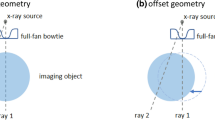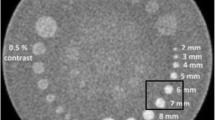Abstract
Computed tomography is widely used for disease detection. On many occasions, image quality is affected due to the effect of hardening the X-ray beam, generating artifacts. In the present research, several methods used for the reduction of metallic artifacts (NMAR, ISMAR and LIMAR) were adapted to the reduction of artifacts by X-ray beam hardening, evaluating their effectiveness through quantitative and qualitative metrics of image quality on regions of interest (ROI). The metrics were: signal-to-noise ratio, image contrast, edge visibility, 10% of the MTF and the expert evaluation on a 8 points scale. The different methods were implemented on Matlab. To study its performance, images corrupted with this type of artifact from a physical phantom and two from patients were used. The method that showed the best performance was NMAR, but its computational efficiency for clinical routine is highly dependent on the hardware used. The methods studied do not provide satisfactory results in images that present large areas of very dense tissue.
Access this chapter
Tax calculation will be finalised at checkout
Purchases are for personal use only
Similar content being viewed by others
References
Barrett, J., Keat, N.: Artifacts in CT: recognition and avoidance. Radiographics 24, 1679–1691 (2004). https://doi.org/10.1148/rg.246045065
Luo, S., Wu, H., et al.: A fast beam hardening correction method incorporated in a filtered back-projection based MAP algorithm. Phys. Med. Biol. 62, 1810–1830 (2017). https://doi.org/10.1088/1361-6560/aa56b5
Sarkar, S., Wahi, P., Munshi, P.: An empirical correction method for beam-hardening artifact in Computerized Tomography (CT) images NDT E Int. 102, 104–113 (2019). https://doi.org/10.1016/j.ndteint.2018.11.009
Abdurahman, S., Frysch, R., et al.: Beam hardening correction using cone beam consistency conditions. IEEE Trans. Med. Imaging 37, 2266–2277 (2018). https://doi.org/10.1109/TMI.2018.2840343
Zhao, W., Li, D., et al.: Multi-materials beam hardening artifacts correction for computed tomography (CT) based on X-ray spectrum estimation. arxiv.org, 2018 (2021). https://arxiv.org/abs/1812.02365. Accessed 3 July 2021
Ghani, M., Karl, W.: Deep learning based sinogram correction for metal artifact reduction. Electron. Imaging XVI, 4721-4728 (2018). https://doi.org/10.2352/ISSN.2470-1173.2018.15.COIMG-472
Gjesteby, L., Shan H., et al.: A dual-stream deep convolutional network for reducing metal streak artifacts in CT images. Phys. Med. Biol. 64, 23503 (2019). https://doi.org/10.1088/1361-6560/ab4e3e
Pauwels, R., Cao, W., et al.: Exploratory research into reduction of scatter and beam hardening in industrial computed tomography using convolutional neural networks. In: Proceedings of the 9th International Conference on Industrial Computed Tomography, pp. 1–8. Padova (2019)
**, H., Dongjoon, K., Yeong-Gil, S., Ho, L.: Metal artifact reduction method based on a constrained beam-hardening estimator for polychromatic x-ray CT. Phys. Med. Biol. 66, 065025 (2021)
Nazemi, E., Six, N., Iuso, D., De Samber, B., Sijbers, J., De Beenhouwer, J.: Monte-carlo-based estimation of the X-ray energy spectrum for CT artifact reduction. Appl. Sci. 11, 3145 (2021). https://doi.org/10.3390/app11073145
Inkinen, S., Mikael, A., Juntunen, K., Ketola, J., Korhonen, K., Kotiaho, A., et al.: Virtual monochromatic imaging reduces beam hardening artefacts in cardiac interior photon counting computed tomography: a phantom study with cadaveric specimens. Biomed. Phys. Eng. Express 8, 015029 (2021)
Koehler, T., Brendel, B., et al.: A New Method for Metal Artifact Reduction in CT. CT Meeting. Computer Science, pp. 29–32 (2012)
Meyer, E., Raupach, R., et al.: Normalized metal artifact reduction (NMAR) in computed tomography. Med. Phys. 37, 5482–5493 (2010). https://doi.org/10.1118/1.3484090
Rodríguez-Gallo, Y., Orozco-Morales, R., Pérez-Díaz, M.: Methods for reducing metal artifacts in computerized tomography nucleus 65, 11–15 (2019). https://www.researchgate.net/publication/335402443
Ruiz-Gonzalez, Y., Perez-Diaz, M., et al.: Objective measurements of image quality in synchrotron radiation phase-contrast imaging vs. digital mammography. Int. JCARS (2015). https://doi.org/10.1007/s11548-015-1237-7
Shi, H., Yang, Z., Luo, S.: Reduce beam hardening artifacts of polychromatic X-ray computed tomography by an iterative approximation approach. J. Xray Sci. Technol. 25, 417–428 (2017). https://doi.org/10.3233/XST-16187
Author information
Authors and Affiliations
Corresponding author
Editor information
Editors and Affiliations
Rights and permissions
Copyright information
© 2024 The Author(s), under exclusive license to Springer Nature Switzerland AG
About this paper
Cite this paper
Perez-Diaz, M., Perez-Duran, A., Pacheco-Chanfrau, Y., Orozco-Morales, R. (2024). Methods for Beam Hardening Artifacts Reduction in CT. In: Marques, J.L.B., Rodrigues, C.R., Suzuki, D.O.H., Marino Neto, J., García Ojeda, R. (eds) IX Latin American Congress on Biomedical Engineering and XXVIII Brazilian Congress on Biomedical Engineering. CLAIB CBEB 2022 2022. IFMBE Proceedings, vol 99. Springer, Cham. https://doi.org/10.1007/978-3-031-49404-8_29
Download citation
DOI: https://doi.org/10.1007/978-3-031-49404-8_29
Published:
Publisher Name: Springer, Cham
Print ISBN: 978-3-031-49403-1
Online ISBN: 978-3-031-49404-8
eBook Packages: EngineeringEngineering (R0)




